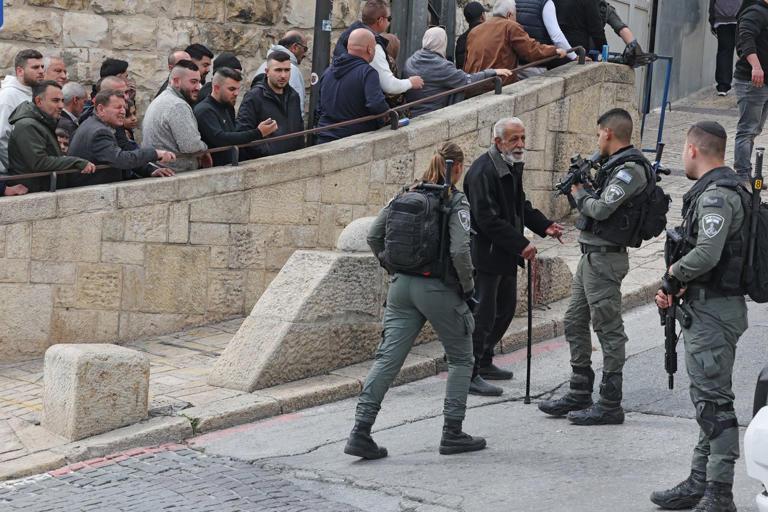
How to Prevent an Iranian Caliphate
Hamas styled its Oct. 7 massacre as retaliation. Its name, Operation Al Aqsa Flood, refers to the Israel Defense Forces’ April 2023 intrusion into the Al Aqsa mosque compound to tame riots and remove weapons stored there. That Israeli soldiers were present—to protect the Temple Mount, Judaism’s holiest site—is a potent symbol of lost sovereignty that Hamas purports to avenge.
Yet Israel isn’t the source of the conflict. It dates to March 3, 1924, the end of the last major Islamic caliphate, which capped the forcible transfer of Islam’s most sacred sites out of Ottoman hands.
The shift to British-allied control over Mecca, Medina and Al Aqsa fulfilled European empires’ campaign to restore the caliphate to the Arabs by removing it from the Turks in Istanbul. The abrupt end, however, left open the question of who protects Muslims and their holy sites. The subtext of the “Al Aqsa Flood” is that its current Arab guarantors, Jordan and Saudi Arabia, haven’t done so. (The Amman-controlled Waqf is in charge of security for Al Aqsa, while Riyadh oversees Mecca and Medina.)
Hamas’s assault violated Israel’s borders, reflecting its agenda of reverting to pre-European frontiers. Similarly, when ISIS crashed through the Syrian border a decade ago, it did so to restore Al-Sham—an area consisting of historical Palestine, Syria, Lebanon, Jordan and parts of Egypt and Turkey—erasing the nation-states it considered to be colonialist slave names.
The missing caliphate has presented an opportunity for Iran, whose 1979 revolution restored religious rule. The mullahs proclaimed their desire to reconquer Jerusalem by holding the first annual “Al Quds day,” the Arabic name for the city, in rejection of the budding peace between Israel and Egypt. The Saudis were similarly threatened when insurgents occupied the Great Mosque of Mecca for two weeks that year.
But Tehran took a back seat to the regional Sunni bloc. When Hamas suicide bombers attacked Israeli civilians in the 2000 Al Aqsa intifada, they weren’t seen to be acting at Iran’s behest. As Sunni regimes have gradually normalized relations with Israel, that dynamic has changed.
The Oct. 25 photograph of Hamas, Islamic Jihad and Hezbollah leaders meeting under the portraits of Iranian ayatollahs is a striking sign of the times. The kinetic activation of Iran’s alliances beyond Hezbollah and the Houthis completes an arc of cross-sectarian influence stretching from Syria to Yemen.
Whether this amounts to Iran’s caliphal moment or a desperate effort against a turning regional tide is unclear. On the one hand, the Saudis are on the verge of becoming the seventh Arab state to recognize Israel. On the other, Iran’s spoiler role in Mideast peace talks reflects geopolitical shifts that eliminated many of its rivals in the past two decades. Iraq lurched from Sunni-led counterweight into Iran’s column, while Afghanistan came under Islamic rule. The U.S. and its allies took care of al Qaeda and ISIS. By empowering proxies to attack the custodians of Islam’s holiest sites, Iran emerges as the military defender of an alternative regional order.
The Gaza war is a reminder that the Europeans left behind an unstable status quo a century ago. Absent a Sunni consensus, Iran is making an indirect power play. Iran’s weakness is also a strength: As non-Arab, Shiite Muslims, Iran’s leaders can’t trace their ancestry to the prophet Muhammad’s qureysh tribe—as can Jordan’s and Morocco’s monarchs, and as ISIS’s Abu Bakr al-Baghdadi claimed. Though around 85% of Muslims are Sunni, the demography of global Islam has long favored much larger non-Arab populations.
The dynamic might be resolved with a Vatican City-style solution for Al Aqsa. Those responsible for overseeing the complex would include Saudi Arabia and Jordan but also Muslims from Turkey, Indonesia, Egypt, Morocco, Algeria, Pakistan, Nigeria and Muslim-minority countries. Free from Western government interference, the arrangement would have to retain Jewish rights to visit and pray at the Temple Mount. Israeli soldiers’ presence could be defused by cooperative patrols alongside the soldiers of countries with which the Jewish state has built thick relations.
As for security considerations, the stakes of a nuclear-powered Iran make the extension of a North Atlantic Treaty Organization-style umbrella to Saudi Arabia seem less outlandish. A nuclear deterrent would obviate the need for U.S. military bases, which would present credibility issues for the Saudis and security risks for American troops.
A comprehensive deal would threaten Iran’s interests by sealing Hashemite and Saudi oversight of Al Aqsa and uniting custodianship of Islam’s three holiest sites for the first time since the Ottomans. Tehran and its proxies would still wish to protest—but with broad Islamic involvement, including outreach to Shiite communities, the protection of international law, and Israeli consultation, the project can defang their threats and assert a unified profile where disunity has prevailed.
Mr. Laurence is director of the Clough Center of the Study of Constitutional Democracy at Boston College and author of “Coping with Defeat: Sunni Islam, Roman Catholicism and the Modern State” (2021).
Source » msn





